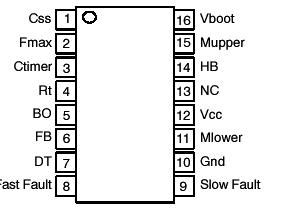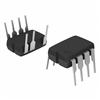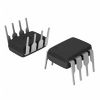Features: • High−frequency Operation from 50 kHz up to 500 kHz
• 600 V High−voltage Floating Driver
• Selectable Minimum Switching Frequency with ±3% Accuracy
• Adjustable Deadtime from 100 ns to 2 �s.
• Startup Sequence via an Adjustable Soft−start
• Brown−out Protection for a Simpler PFC Association
• Latched Input for Severe Fault Conditions, e.g. Over Temperature or OVP
• Timer−based Input with Auto−recovery Operation for Delayed Event Reaction
• Enable Input for Immediate Event Reaction or Simple ON/OFF Control
• VCC Operation up to 20 V
• Low Startup Current of 300 �A
• 1 A / 0.5 A Peak Current Sink / Source Drive Capability
• Common Collector Optocoupler Connection for Easier ORing
• Internal Temperature Shutdown
• B Version features 10 V VCC Startup Threshold
• SO16 or DIP16 PackageApplication• Flat Panel Display Power Converters
• High Power AC/DC Adapters for Notebooks
• Industrial and Medical Power Sources
• Offline Battery ChargersPinout Specifications
Specifications
|
Rating |
Symbol
|
Value |
Unit |
|
High Voltage bridge pin, pin 14 |
VBRIDGE |
−1 to 600 |
V |
|
Floating supply voltage, ground referenced |
VBOOT− VBRIDGE |
0 to 20 |
V |
|
High side output voltage |
VDRV_HI |
VBRIDGE−0.3 to
VBOOT+0.3 |
V |
| Low side output voltage |
VDRV_LO |
−0.3 to VCC + 0.3 |
V |
| Allowable output slew rate |
dVBRIDGE/dt |
50 |
V/ns |
| Power Supply voltage, pin 12 |
Vcc |
20 |
V |
| Maximum voltage, all pins (except pin 11 and 10) |
− |
−0.3 to 10 |
V |
| Thermal Resistance − Junction−to−Air, PDIP version |
RJA |
100 |
/W |
| Thermal Resistance − Junction−to−Air, SOIC version |
RJA |
130 |
/W |
| Storage Temperature Range |
− |
−60 to +150 |
|
|
ESD Capability, HBM model (All pins except VCC and HV) |
− |
2 |
kV |
| ESD Capability, Machine Model (All pins except pin 11 see Note 1) |
− |
200 |
V |
Stresses exceeding Maximum Ratings may damage the device. Maximum Ratings are stress ratings only. Functional operation above the Recommended Operating Conditions is not implied. Extended exposure to stresses above the Recommended Operating Conditions may affect device reliability.
1. This device series contains ESD protection and exceeds the following tests:
Human Body Model 2000 V per Mil−Std−883, Method 3015 Machine Model Method 200 V ESD Capability,
Machine Model for pin 11 is 180 V.
2. This device meets latch−up tests defined by JEDEC Standard JESD78.
DescriptionThe NCP1396B offers everything needed to build a reliable and rugged resonant mode power supply. Its unique architecture includes a 500 kHz Voltage Controller Oscillator whose control mode brings flexibility when an ORing function is a necessity, e.g. in multiple feedback paths implementations. Thanks to its proprietary high−voltage technology, the controller welcomes a bootstrapped MOSFET driver NCP1396B for half−bridge applications accepting bulk voltages up to 600 V. Protections featuring various reaction times, e.g. immediate shutdown or timer−based event, brown−out, broken opto−coupler detection etc., contribute to a safer converter design, without engendering additional circuitry complexity. An adjustable deadtime of NCP1396B also helps lowering the shoot−through current contribution as the switching frequency increases.

 NCP1396B Data Sheet
NCP1396B Data Sheet








